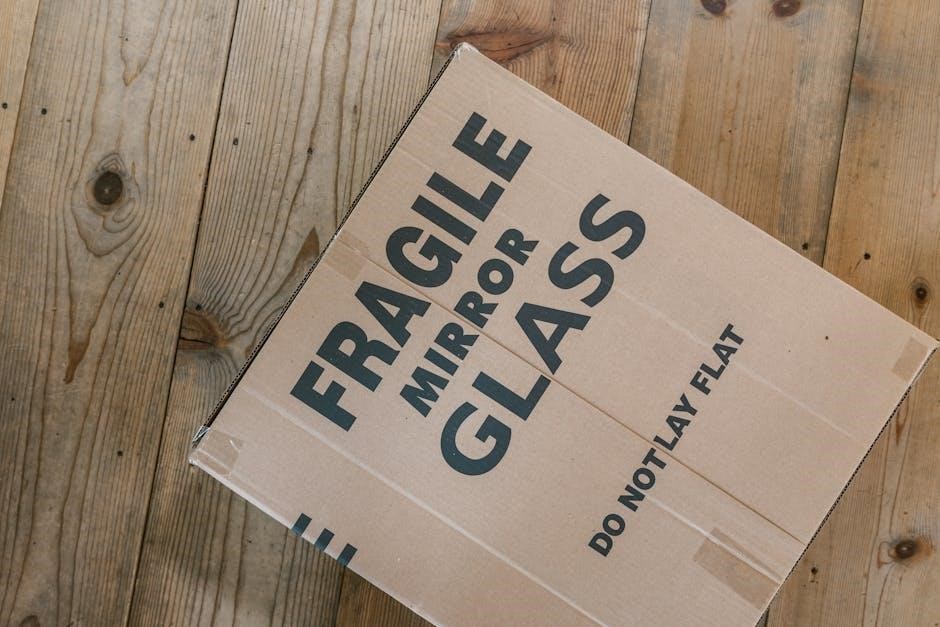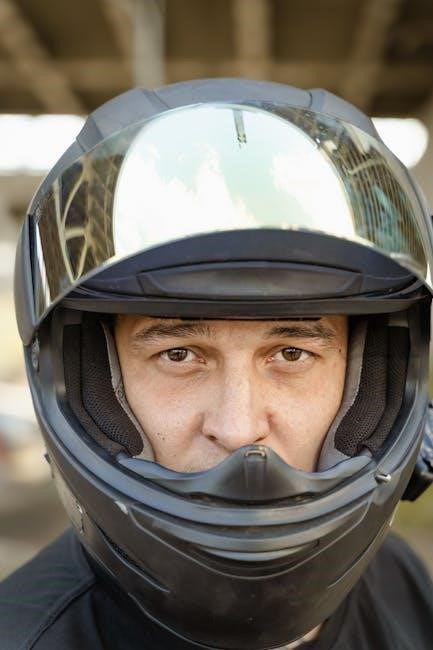Derm Shield is a transparent, breathable film designed for tattoo aftercare. It protects tattoos from bacteria, reduces irritation, and retains moisture for optimal healing. Dermatologist-recommended for its flexibility and ease of use, Derm Shield is a top choice for promoting healthy skin regeneration and vibrant ink retention.
1.1 What is Derm Shield?
Derm Shield is a thin, transparent, matte adhesive film designed to protect and care for tattoos during the healing process. It is applied directly over the tattooed area, offering a breathable barrier that prevents bacteria, dust, and other contaminants from interfering with the healing process. The film is flexible, allowing it to conform to various body parts, and is typically cut to size to cover the tattoo with a small margin around the edges. Derm Shield is applied after the tattoo is cleaned and dried, creating a protective environment that promotes healthy skin regeneration and vibrant ink retention.
1.2 Benefits of Using Derm Shield
Derm Shield offers numerous benefits for tattoo aftercare, including its breathable design that prevents moisture buildup and reduces the risk of infection. It protects the tattoo from bacteria, dust, and irritants, promoting a clean healing environment. The transparent film allows for easy monitoring of the tattoo’s progress without removal. Derm Shield also minimizes scabbing and peeling, which can damage the tattoo’s appearance. Its adhesive is gentle on the skin, reducing irritation, and it retains moisture to keep the tattoo hydrated. This makes the healing process smoother and less prone to complications, ensuring vibrant and long-lasting results.
1.3 Why Derm Shield is Recommended for Tattoo Aftercare
Derm Shield is highly recommended for tattoo aftercare due to its unique combination of breathability and protection. It creates a sterile barrier that prevents bacteria and contaminants from reaching the tattoo, reducing the risk of infection. The film’s flexibility allows it to conform to various body parts without restricting movement, making it ideal for tattoos on elbows, knees, or other joints. Additionally, Derm Shield’s transparent design lets you monitor healing progress without removing the product. Its gentle adhesive ensures minimal irritation, and it retains essential moisture to promote faster healing. These features make Derm Shield a top choice for both tattoo artists and clients seeking optimal aftercare solutions.
Step-by-Step Application Guide
Cut Derm Shield to size, leaving a small border around the tattoo. Peel the backing, position it smoothly over the tattoo, and press firmly to ensure proper adhesion.
2.1 Preparing the Tattooed Area
Before applying Derm Shield, wash your hands thoroughly. Gently clean the tattooed area with warm water and a mild, fragrance-free soap. Rinse the soap off completely and pat the area dry with a clean towel. Ensure the skin is free of lotions, oils, or excess moisture, as this can interfere with adhesion. Allow the area to air dry fully before proceeding. Proper preparation ensures the Derm Shield adheres correctly and promotes a hygienic environment for healing.
2.2 Cutting Derm Shield to Size
To ensure a proper fit, cut the Derm Shield film to match the size of your tattoo, leaving a 1-inch margin around the edges. Use sharp, clean scissors for precise cuts. Align the film with the tattoo’s shape, ensuring it’s slightly larger but not excessively so. Avoid stretching the Derm Shield while cutting, as this can create air bubbles or misalignment. Once cut, set the piece aside, ready for application. Proper sizing ensures the film adheres smoothly and covers the tattoo evenly, promoting optimal healing conditions.
2.3 Peeling Off the Backing Layer
Once the Derm Shield is cut to size, locate the edge with the printed arrows or markings. Gently peel the backing layer from the corner, working slowly to avoid stretching the film. Peel in one smooth motion to prevent creases or air bubbles. Continue until the entire backing is removed, revealing the adhesive side. Ensure the area is clean and dry before proceeding. The Derm Shield should now be ready for placement over the tattoo. Proper peeling ensures a smooth application and optimal adhesion for healing.
2.4 Positioning Derm Shield Over the Tattoo
Align the cut Derm Shield with the edges of your tattoo, ensuring it is centered for full coverage. Gently place the film over the tattoo, starting from one edge and smoothing it outward with your fingers or a credit card to eliminate air bubbles. Press firmly around the edges to secure adhesion. Ensure the Derm Shield lies flat and wrinkle-free, as any creases can trap bacteria. Proper positioning ensures even healing and prevents fluid from seeping under the edges. Avoid stretching the film, as this can cause it to lose adhesion or tear during wear.
2.5 Ensuring Proper Adhesion
Press the Derm Shield firmly over the tattoo, starting from the center and working outward with your fingers or a credit card to remove air bubbles. Ensure the edges are securely attached by gently pressing them down. Avoid stretching the Derm Shield, as this can reduce adhesion. Proper adhesion prevents fluid leakage and bacteria from entering under the film. If the edges begin to peel, reapply gentle pressure or use a small piece of medical tape to secure them. This step is crucial for maintaining a protective barrier and promoting uninterrupted healing.

Aftercare and Maintenance
Keep the tattoo clean, avoid swimming, and minimize sun exposure. Reapply Derm Shield as needed, ensuring proper adhesion for optimal healing and protection.
3.1 Cleaning the Tattooed Area
Cleaning the tattooed area is crucial for proper healing. Use warm water and a fragrance-free, non-comedogenic soap to gently cleanse the skin. Avoid scrubbing or using harsh products. Rinse thoroughly and pat dry with a clean towel. Ensure the area is completely dry before reapplying Derm Shield. Regular cleaning helps prevent infection and promotes healing. Always wash your hands before touching the tattooed area to maintain hygiene.
3.2 Avoiding Swimming and Sun Exposure
Swimming and sun exposure should be avoided during the healing process to protect the tattoo. Swimming in pools or oceans can expose the tattoo to bacteria, increasing infection risk. Chlorine and saltwater can irritate the skin and delay healing. Similarly, direct sunlight can cause sunburn, fading, and damage to the delicate skin. Keep the tattoo dry and out of direct sun for at least two weeks. If sun exposure is unavoidable, use protective clothing or sunscreen specifically designed for tattoos. This helps preserve the tattoo’s appearance and ensures proper healing.
3.3 Reapplying Derm Shield
Reapplying Derm Shield is essential for maintaining protection and promoting healing. After the initial 24-hour period, remove the Derm Shield, clean the tattoo with warm water and fragrance-free soap, and gently pat it dry. Cut a new piece of Derm Shield to size, ensuring it covers the tattoo with a small margin around the edges. Peel off the backing and apply it smoothly, avoiding air bubbles. Reapply Derm Shield every 3-4 days or as needed, ensuring the area remains clean and dry between applications. This process can be repeated for up to two weeks, depending on healing progress.
3.4 Duration of Use
Derm Shield is typically used for several days to ensure proper healing. Apply it immediately after getting a tattoo and keep it on for the first 24 hours. After that, reapply fresh Derm Shield every 3-4 days, depending on your tattoo’s healing progress. Most users apply it for up to two weeks, but this may vary. Always ensure the area is clean and dry before reapplying. Avoid leaving Derm Shield on for too long, as this can lead to irritation or hinder the healing process. Follow the recommended duration to achieve the best results for your tattoo.
Removing Derm Shield
To remove Derm Shield safely, start by gently peeling it from one edge. Use warm water to soften the adhesive if needed. After removal, clean the tattoo with soap and water to ensure proper hygiene. Avoid harsh scrubbing to prevent irritation. Proper removal helps maintain the tattoo’s health and promotes smooth healing. Always clean the area thoroughly after taking off Derm Shield to prevent infection and ensure the best results for your tattoo.
4.1 When to Remove Derm Shield
Derm Shield should typically be removed after 24 hours for the initial application. Following this, it can be reapplied for 3-4 days. Remove it when the edges start peeling or fluid leaks out. Avoid leaving it on for more than a week, as this may hinder healing. Always clean and dry the area before reapplying. If irritation occurs, discontinue use. Proper timing ensures the tattoo heals optimally without complications. Monitor the tattoo’s condition and adjust removal schedules as needed to maintain health and prevent infections. Always follow the recommended duration for best results. Keep the area clean after removal.
4.2 How to Remove Derm Shield Safely
To safely remove Derm Shield, start by gently peeling it from one edge. Use warm water to soften the adhesive if needed; Avoid pulling forcefully to prevent skin irritation. Once removed, clean the area with mild soap and warm water, then pat dry with a clean towel. If irritation occurs, remove the shield and discontinue use. Always ensure the skin is clean and dry before reapplication or further aftercare. Proper removal prevents complications and supports healing.
4.3 Post-Removal Care
After removing Derm Shield, gently clean the area with warm water and a fragrance-free soap. Pat dry with a clean towel, avoiding rubbing. Apply a thin layer of unscented ointment to keep the skin moisturized and promote healing. Avoid tight clothing that may cause friction or irritation. Monitor the area for any signs of redness or itching, which could indicate an allergic reaction. If any issues arise, consult a professional for advice. Proper post-removal care ensures the tattoo continues to heal smoothly and reduces the risk of complications.
Tips for Best Results
Keep the tattooed area dry, avoid tight clothing, and monitor for allergic reactions. Avoid swimming and sun exposure during healing for optimal results and vibrant ink retention.
5.1 Keeping the Area Dry
Keeping the tattooed area dry is crucial for proper healing. After applying Derm Shield, ensure the skin remains moisture-free to prevent bacterial growth. Gently pat the area dry after cleaning, avoiding excessive rubbing. This helps maintain the integrity of the Derm Shield and promotes a healthy environment for your tattoo to heal. Regularly inspect the area for any signs of moisture buildup and address it promptly to avoid complications.
5.2 Avoiding Tight Clothing
Avoiding tight clothing is essential when using Derm Shield to ensure proper healing. Tight garments can cause friction, leading to irritation and potentially dislodging the Derm Shield. This friction may also cause the tattoo to rub against the fabric, increasing the risk of inflammation or delayed healing. Additionally, tight clothing can restrict airflow, promoting moisture buildup under the Derm Shield, which may create an environment for bacteria to thrive. Opting for loose, breathable fabrics like cotton allows the skin to heal more effectively and prevents unnecessary complications during the recovery process.
5.3 Monitoring for Allergic Reactions
Monitoring for allergic reactions is crucial when using Derm Shield. While rare, some individuals may experience sensitivity to the adhesive or materials. Signs include redness, itching, or rashes around the edges of the Derm Shield. If such symptoms occur, remove the product immediately and gently clean the area with warm water and mild soap.
After removal, assess the severity of the reaction. If irritation persists or worsens, consult a healthcare professional for advice. Discontinue use if an allergic reaction is confirmed, and consider alternative aftercare methods recommended by your tattoo artist or dermatologist.

Common Mistakes to Avoid
Overstretching Derm Shield, using excessive water, and ignoring proper cleaning procedures are common mistakes. These can lead to poor adhesion, bacterial growth, and delayed healing.
6.1 Overstretching the Derm Shield
Overstretching Derm Shield can compromise its adhesive properties and reduce its effectiveness. When the film is stretched too thin, it may lose its grip on the skin, leading to poor adhesion and exposure of the tattoo to contaminants. This can increase the risk of infection and delay healing. To avoid this, cut Derm Shield slightly larger than the tattoo area and apply it gently without pulling or stretching excessively. Ensure the surface is flat and smooth before application to maintain proper contact and prevent air bubbles or wrinkles.
6.2 Using Too Much Water
Using excessive water during the application or cleaning process can negatively impact the adhesion and effectiveness of Derm Shield. Excess moisture may cause the film to lift off prematurely, reducing its protective qualities. Gently clean the tattoo with a small amount of lukewarm water and mild soap, ensuring the area is damp but not soaked. Pat dry thoroughly with a clean towel before applying Derm Shield. Proper hydration without over-saturating the skin ensures optimal adhesion and promotes a healthy healing environment for your tattoo.
6.3 Ignoring Proper Cleaning Procedures
Ignoring proper cleaning procedures can lead to bacterial growth and delayed healing. Always clean the tattooed area with lukewarm water and a mild, fragrance-free soap. Avoid using harsh chemicals or abrasive scrubbers, as they can irritate the skin. Gently massage the area with clean hands or a soft cloth, then rinse thoroughly. Excess water should be patted dry with a clean towel. Neglecting these steps can compromise the protective barrier provided by Derm Shield, increasing the risk of infection and prolonging the healing process. Proper hygiene is essential for maintaining a healthy environment for tattoo recovery.

Signs of Allergic Reactions
Watch for redness, itching, swelling, or rashes around the tattoo area. These are common signs of an allergic reaction to Derm Shield or the tattoo ink.
7.1 Identifying Irritation
Identifying irritation when using Derm Shield involves monitoring for redness, swelling, or itching around the tattoo area. Mild irritation may include a rash or discomfort, while severe reactions can cause blistering or intense inflammation. It’s crucial to inspect the skin regularly, especially after applying Derm Shield. If irritation persists or worsens, remove the Derm Shield immediately and consult a professional. Proper cleaning and monitoring can help prevent complications, ensuring the tattoo heals smoothly and reducing the risk of allergic reactions.
7.2 What to Do If a Reaction Occurs
If a reaction occurs while using Derm Shield, remove it immediately and gently clean the area with warm water and a non-scented soap. Pat dry thoroughly and apply a fragrance-free, non-comedogenic moisturizer to soothe irritation. Avoid further use of Derm Shield if the reaction persists. Monitor the area closely for signs of infection, such as increased redness or pus. Consult a healthcare professional or tattoo artist for guidance. Discontinue use if irritation recurs, and consider alternative aftercare methods to ensure proper healing and prevent further complications.
Derm Shield is a protective, breathable solution for tattoos, promoting healing and vibrant results. Proper use ensures optimal outcomes and long-lasting ink integrity.
8.1 Final Tips for Successful Healing
For optimal results, keep the tattooed area dry and avoid tight clothing to prevent irritation. Monitor for allergic reactions and ensure proper adhesion of Derm Shield. Reapply as needed, following the instructions carefully. Avoid swimming and sun exposure during the healing process to protect the tattoo. Maintain cleanliness and dryness between applications. By adhering to these guidelines, you can promote healthy healing and achieve vibrant, long-lasting results. Proper care ensures your tattoo heals beautifully and retains its color and detail.
8.2 Importance of Following Instructions
Adhering to the provided instructions ensures proper healing and minimizes risks of complications. Improper use of Derm Shield can lead to irritation or delayed healing. Following the step-by-step guide helps maintain the integrity of the tattoo and promotes optimal results. Consistency in application and aftercare routines is essential for achieving vibrant, healthy skin. Ignoring instructions may compromise the tattoo’s appearance, so attention to detail is crucial. By prioritizing the recommended care, you safeguard your investment in your tattoo and ensure a smooth recovery process.